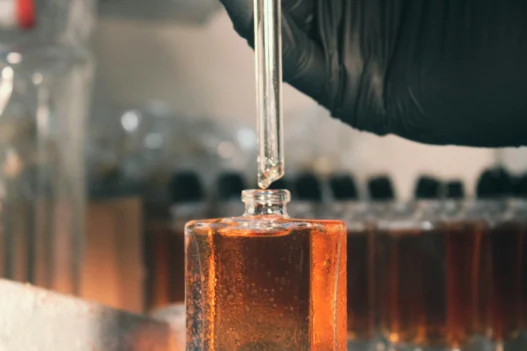4-Bromo-N,N-dimethylaniline is a chemical compound primarily used as a reagent in organic synthesis and pharmaceutical research. While it may not have direct relevance to everyday life for the average individual, its applications in drug development and industrial processes are significant. This compound is utilized in the creation of various medications and in the production of dyes and pigments. Its role in the advancement of pharmaceuticals and other products underscores its importance in both scientific research and commercial industries.
Table of Contents:
- 💡 Commercial Applications
- ⚗️ Chemical & Physical Properties
- 🏭 Production & Procurement
- ⚠️ Safety Considerations
- 🔬 Potential Research Directions
- 🧪 Related Compounds
💡 Commercial Applications
4-Bromo-N,N-dimethylaniline, a chemical compound primarily utilized in the development of dyes and pigments, boasts various commercial applications. Its ability to impart rich and vibrant colors to textiles and other materials makes it a valuable component in industries such as fashion and cosmetics. Additionally, its use in the creation of photographic and printing inks further solidifies its importance in commercial ventures.
In the realm of drug and medication applications, 4-Bromo-N,N-dimethylaniline plays a crucial role as an intermediate in the synthesis of pharmaceutical compounds. Its unique chemical structure allows for the creation of potent and effective medications that target specific biological pathways. Furthermore, its presence in pharmaceutical research and development labs underscores its significance in advancing medical treatments for various ailments.
Overall, the versatile nature of 4-Bromo-N,N-dimethylaniline lends itself to a wide range of commercial and industrial applications. Its importance in industries such as textiles, cosmetics, and pharmaceuticals highlights its value as a key ingredient in the creation of vibrant colors, effective medications, and innovative products.
⚗️ Chemical & Physical Properties
4-Bromo-N,N-dimethylaniline is a pale yellow to brown solid with a faint amine-like odor. Its appearance may vary depending on impurities present in the sample.
The molar mass of 4-Bromo-N,N-dimethylaniline is approximately 209.08 g/mol, and its density is around 1.277 g/cm³. This places it in the range of molar masses and densities commonly found in certain food items such as sugars and proteins.
4-Bromo-N,N-dimethylaniline has a melting point of around 22-24°C and a boiling point of approximately 248-250°C. In comparison to common food items, its melting and boiling points are higher than those of substances like sugar and salt.
4-Bromo-N,N-dimethylaniline is sparingly soluble in water and exhibits a relatively low viscosity. This contrasts with many common food items that are highly soluble in water and have varying viscosities based on their composition.
🏭 Production & Procurement
4-Bromo-N,N-dimethylaniline is typically produced through the bromination of N,N-dimethylaniline. This chemical reaction involves the addition of bromine to the N,N-dimethylaniline compound, resulting in the formation of 4-Bromo-N,N-dimethylaniline as the final product.
The procurement of 4-Bromo-N,N-dimethylaniline can be carried out through chemical suppliers or manufacturers. It is available for purchase in varying quantities, from small laboratory-grade quantities to bulk industrial quantities. The compound can be transported in sealed containers or drums, following standard safety protocols for handling and storage of hazardous chemicals.
When procuring 4-Bromo-N,N-dimethylaniline, it is crucial to ensure compliance with regulations regarding the handling and transportation of hazardous chemicals. Proper labeling, documentation, and safety precautions should be followed to prevent accidents or exposure to the compound. It is advisable to work with certified suppliers or reputable manufacturers to ensure the quality and integrity of the product.
⚠️ Safety Considerations
Safety considerations for handling 4-Bromo-N,N-dimethylaniline include proper personal protective equipment such as gloves, goggles, and a lab coat to prevent skin and eye contact. It is important to work in a well-ventilated area to avoid inhalation and to wash hands thoroughly after handling. In case of accidental exposure, seek medical attention immediately.
Hazard statements for 4-Bromo-N,N-dimethylaniline include “causes serious eye irritation,” “may cause respiratory irritation,” and “toxic to aquatic life with long-lasting effects.” It is important to handle this compound with care and to avoid any unnecessary exposure to it to prevent potential health risks and environmental harm.
Precautionary statements for 4-Bromo-N,N-dimethylaniline include wearing protective gloves, clothing, and eye protection while handling. It is advised to only use this compound in a well-ventilated area and to avoid releasing it into the environment. In case of skin or eye contact, rinse thoroughly with water and seek medical advice.
🔬 Potential Research Directions
One potential research direction for 4-Bromo-N,N-dimethylaniline involves studying its use as a precursor in organic synthesis reactions to create various heterocyclic compounds with potential pharmaceutical applications.
Another area of interest could be exploring the toxicological effects of 4-Bromo-N,N-dimethylaniline on human health and the environment, considering its potential as a carcinogen or environmental pollutant.
Furthermore, research could be conducted to investigate the photophysical properties of 4-Bromo-N,N-dimethylaniline, such as its fluorescence behavior, which could have implications for its use in analytical techniques or materials science.
Lastly, exploring the chemical reactivity of 4-Bromo-N,N-dimethylaniline with other compounds could lead to the development of novel reactions or catalysts that could have practical applications in the synthesis of complex molecules.
🧪 Related Compounds
One similar compound to 4-Bromo-N,N-dimethylaniline is 4-Chloro-N,N-dimethylaniline. In this compound, the bromine atom in 4-Bromo-N,N-dimethylaniline is replaced with a chlorine atom, resulting in a compound with a similar molecular structure. This substitution can alter the compound’s physical and chemical properties, possibly affecting its interactions with other substances.
Another related compound is N,N-dimethylaniline, which lacks the bromine substituent found in 4-Bromo-N,N-dimethylaniline. By removing the bromine group, the molecular structure is simplified, potentially impacting the compound’s reactivity and biological activity. Despite this difference, the presence of dimethylamine groups in both compounds underscores their similarity in terms of molecular composition.
It is also worth mentioning N,N-dimethyl-4-aminobiphenyl as a related compound to 4-Bromo-N,N-dimethylaniline. This compound differs from 4-Bromo-N,N-dimethylaniline in the presence of a biphenyl group and the absence of a bromine atom. This substitution may lead to variations in the compound’s physical and chemical properties, illustrating how minor structural changes can result in significant differences in compound behavior.






